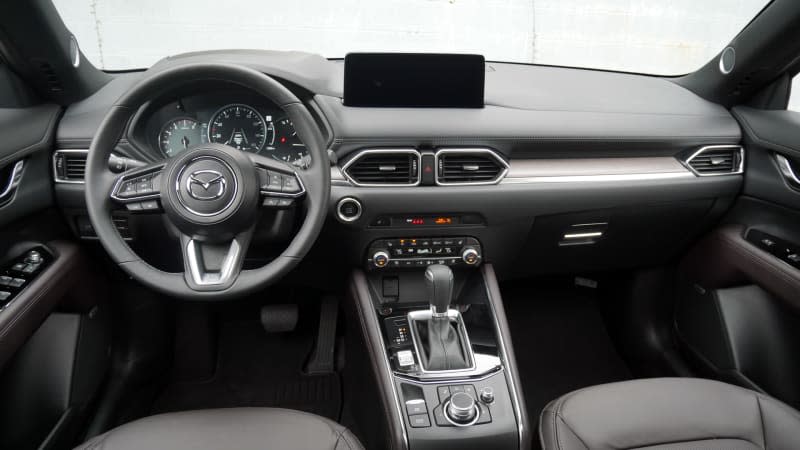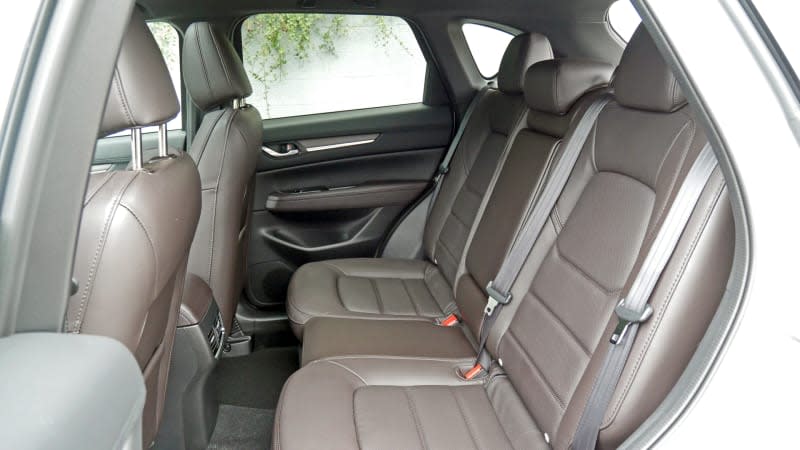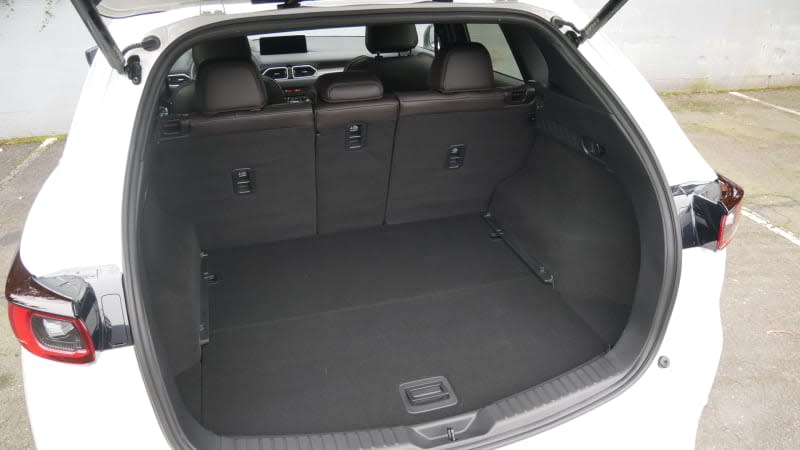2024 Mazda CX-5 Review: Why get option 1b when 1a is sitting right there?

Pros: Engaging and refined to drive; luxurious interior; strong turbo engine; good looks; top crash scores
Cons: No hybrid available; polarizing infotainment system; a bit small; not as good as CX-50
What exactly do you get with the number 0? Usually, by definition, nothing. But when it comes to Mazda’s pair of compact SUVs, the 2024 Mazda CX-5 isn’t as appealing as its newer sibling, the CX-50. Both have the same list of pros and cons, and both represent sportier and more premium takes on a segment that mostly consists of family-oriented or outdoor adventure entries. They’re even similar in size and offer the same engine choices. What the heck’s the difference, then?
Basically, the CX-50 was designed and engineered for the North American market versus the more globally minded CX-5. It therefore offers all the virtues of the CX-5, but is a smidge bigger, more refined and capable of going further off-road. We think it looks better, too. Oh, and it’s made in America versus the made-in-Japan CX-5. Why opt for the CX-5, then? Apart from a slightly lower price, we’re left scratching our heads. While we theoretically like it every bit as much as before the CX-50 came out, and still appreciate that it strikes a more emotional chord than the CR-Vs and RAV4s of the world, we just like the CX-50 more. Why go for option 1b when 1a is just sitting right there?
Interior & Technology | Passenger & Cargo Space | Performance & Fuel Economy
What it's like to drive | Pricing & Trim Levels | Crash Ratings & Safety Features
What's new for 2024?
Changes are minimal, starting with the disappearance of the base S trim — a popular move for automakers lately, shedding the low-hanging, questionably profitable fruit. This makes the CX-5 $2,600 more expensive to start after factoring the price increase on the S Select trim that's now the entry-level model. There are changes further up the trim order, too. The Carbon Turbo returns, recalling the Carbon Turbo Edition that hasn't been seen since the 2021 model year. Mazda rolls out new color combos for this trim, the 2024 Carbon Turbo offering a special Zircon Sand Metallic paint for $450 and a Terracotta leather interior mixed with black suede. As before, it slips in as the most accessible variant with the turbocharged 2.5-liter, below the current Turbo that's renamed Turbo Premium for 2024, and the top-tier Turbo Signature.

What are the CX-5 interior and in-car technology like?
The CX-5 boasts a handsome, upscale design with materials to match, exuding a premium vibe that none of its direct competitors can match (well, besides the CX-50). Its top trim levels have seats that are heated all around and ventilated up front, plus high-quality leather with contrast French stitching. The Signature gets unique Catarra Brown Nappa leather, shown here. The padded and stitched pleather on the dash, doors and center console are a nice touch too, as is the alloy trim — especially the air vents that seem to jut out from within the dash. Admittedly, fancier touches like the Signature's wood-look trim are absent on lower trim levels, but the overall interior ambience remains more premium and stylish than those of most competitors — especially something like the Toyota RAV4 and Subaru Forester that are going for more of a rugged, utilitarian vibe.
Mazda's tech interface is distinctive in that it uses a center console knob controller rather than a touchscreen. This isn't Mazda being behind the times, it's a conscious effort to reduce driver distraction. The dashtop screen is large and easy to see while running a relatively simple and quick user interface. The knob that controls it is big, ergonomically placed on the center console and, like BMW's iDrive controller, can rotate through menus or move up/down, left/right among icons. This latter feature is key for using Apple CarPlay and Android Auto, which is where the troubles begin. Both connectivity features are intended for a touchscreen, and selecting their icons by rotating and clicking the knob is more time consuming and distracting. There’s a reason Mazda added touchscreen functionality to the CX-50 specifically for CarPlay and Android Auto. That said, wheeling through playlists or contacts is actually easier with a knob, and unlike most other manufacturers, Mazda doesn't lock out those functions while the vehicle is in motion (good news for passengers).
How big is the CX-5?
Although the CX-5 is smaller on the outside than the CX-50, they are virtually identical inside apart from some extra width in the CX-50. Either way, both are on the small end of the compact SUV segment. The CX-5 has adequate space inside for four occupants to ride around in relative comfort, but families may find they could use the sort of extra space provided by the Honda CR-V, Hyundai Tucson and Toyota RAV4. Kids are more likely to end up kicking the front seats from front-facing child seats, and those up front are more likely to need to scoot their seats up to make room for rear-facing child seats. We found that in our car seat comparison of four compact SUVs, the CX-5 was the least friendly in terms of car seat space and fitment, but it wasn't a huge gap to those ahead.
The CX-5 has 30.9 cubic-feet of space behind its back seat, which is considerably less than those competitors. The CX-50 has 31.4 cubic-feet, so ditto. Not surprisingly, we found they can’t hold quite as much stuff as those competitors with bigger volumes (all links here go to their respective luggage tests): the Kia Sportage (39.6), Hyundai Tucson (38.6), Toyota RAV4 (37.5), 2023 Honda CR-V (36) and the Subaru Forester (between 33 and 35 depending on options). Nevertheless, the CX-5 does represent a clear upgrade over various subcompact SUVs like Mazda's CX-30.


What are the CX-5 fuel economy and performance specs?
Mazda CX-5 trim levels with 2.5 S in their name feature a 2.5-liter inline-four that produces 187 horsepower and 186 pound-feet of torque. A six-speed automatic transmission and all-wheel drive are standard. It's a unique AWD system that monitors vehicle weight distribution among the usual factors of throttle position and current traction in order to improve response and handling. Fuel economy estimates for 2024 were not available at this time, but it’s highly unlikely they’d change substantially after last year’s of 24 mpg city, 30 mpg highway and 26 mpg combined. These are lower than the CR-V, Forester and RAV4, which fall in the 28-29 mpg combined range. The CR-V and RAV4, plus the Kia Sportage and Hyundai Tucson, also offer more efficient and highly recommended hybrid powertrains.
Trim levels with 2.5 Turbo in their name feature a 2.5-liter turbocharged inline-four good for 227 hp and 310 lb-ft of torque. It'll do 256 hp on 93 octane if you live in a place that sells that and you feel like paying more for gas. Either way, this engine produces the sort of energetic acceleration that few others in the segment can match, including none of those competitors above. It too is paired with a six-speed automatic and all-wheel drive. Fuel economy drops further down to 22 mpg city, 27 mpg highway and 24 mpg combined.

What's the CX-5 like to drive?
Mazda’s compact crossover is perfect for the person whose life changes have dictated the switch from an agile car to some sort of family hauler. Its spot-on steering and throttle response evoke Porsche, while the six-speed automatic transmission favors performance over fuel economy (while still getting relatively good mileage). Those dynamic elements, plus a carefully crafted, ideal driving position and the ample grunt from the available turbo engine should make the CX-5 feel "just right" for those used to more sporting, non-family-oriented transport. That said, its ride quality is on the firmer side. It's never harsh, even with big wheels, but you certainly feel more of the road than in most competitors.
Part of its dynamic prowess comes from the fact that G-Vectoring Control Plus, technology exclusive to Mazda, uses engine torque to shift weight onto the front wheels just as turn-in is initiated. That provides more grip on the turning wheels, and while it's most noticeable in poor road conditions, it further instills the driver with a calm assurance on the curviest of roads even when surfaces are dry. It can also apply the outside wheel's brake, which guides the vehicle with the sort of smooth control typically reserved for sports sedans.

 Yahoo Autos
Yahoo Autos 
